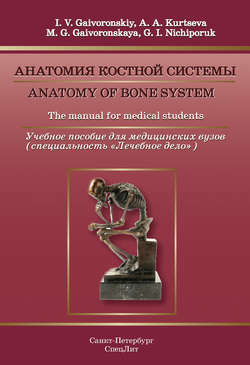Читать книгу Anatomy of bone system. The manual for medical students / Анатомия костной системы. Учебное пособие для медицинских вузов - Г. И. Ничипорук - Страница 21
2. SKELETON OF TRUNK
2.5. Sacrum
ОглавлениеThe sacrum, os sacrum (SI– SV), consists of five sacral vertebrae, vertebrae sacrales, which fuse to form a single bone in adults. Two parts and two surfaces are distinguished in the sacrum: the upper wide part, which is the base of the sacrum, basis ossis sacri; the lower part, which is the apex of the sacrum, apex ossis sacri; the anterior (concave) surface, which is the pelvic surface, facies pelviсa; the posterior surface (convex, rough), which is the dorsal surface, facies dorsalis (fig. 2.6).
Fig. 2.6. Sacrum and coccyx:
a – anterior aspect: 1 – anterior sacral foramina (foramina sacralia anteriora); 2 – transverse lines (lineae transversae)
b – posterior aspect: 3 – coccygeal horn (cornu coccygeum); 4 – sacral horn (cornu sacrale); 5 – median sacral crest (crista sacralis mediana); 6 – auricular surface (facies auricularis); 7 – lateral sacral crest (crista sacralis lateralis); 8 – sacral tuberosity (tuberositas ossis sacri); 9 – posterior sacral foramina (foramina sacralia posteriora); 10 – intermediate sacral crest (crista sacralis intermedia); 11 – sacral hiatus (hiatus sacralis)
Fig. 2.7.Sagittal section of sacrum:
1 – sacral canal (canalis sacralis), 2 – base of sacrum (basis ossis sacri); 3 – sacral horn (cornu sacrale)
Fig. 2.8. Horizontal section of sacrum:
1 – posterior sacral foramen (foramen sacrale posterius); 2 – sacral canal (canalis sacralis); 3 – median sacral crest (crista sacralis mediana); 4 – intervertebral foramen (foramen intervertebrale)
The superior articular processes, processus articulares superiores, project from the base of the sacrum; they articulate with the inferior articular processes of the V lumbar vertebra. The place of the junction of the sacrum with the body of the V lumbar vertebra bulges forwards, and is known as the sacral promontory, promontorium.
Four transverse lines, lineae transversae, running horizontally, are visible on the pelvic surface of the sacrum. They are the traces of the fusion of the sacral vertebral bodies. The anterior sacral foramina, foramina sacralia anteriora, open on the right and left ends of these lines.
There are five longitudinal crests on the dorsal surface of the sacrum. The unpaired median sacral crest, crista sacralis mediana, is formed by the fusion of the spinous processes. There is the paired intermediate sacral crest, crista sacralis intermedia, on each side of it. The intermediate sacral crest represents fused articular processes of the sacral vertebrae. There are the posterior intermediate foramina, foramina sacralia posteriora, near the intermediate crests. The paired lateral sacral crest, crista sacralis lateralis, lies laterally to these foramina. It is the trace of the fusion of the transverse processes and rudimental ribs. The paired lateral parts, partes laterales, with the auricular surfaces, facies auriculares, are located outside the posterior sacral foramina. They articulate with the auricular surfaces of the pelvic bone. There is the sacral tuberosity, tuberositas ossis sacri, behind the auricular surfaces. It is connected by ligaments with the tuberosity of the pelvic bone. In the process of the fusion of the sacral vertebrae into a single bone, the vertebral foramina form the sacral canal, canalis caralis (fig. 2.7). It terminates with the sacral hiatus, hiatus sacralis. The sacral horns, cornua sacralia, are on both sides of the hiatus. They are rudiments of the inferior articular processes. The anterior and posterior sacral foramina are connected with the sacral canal by the intervertebral foramina, foramina intervertebralia (fig. 2.8).
